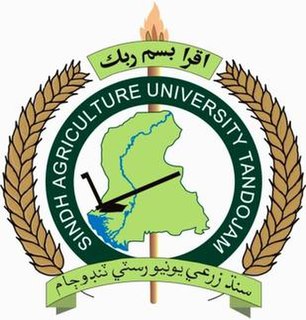
Agricultural science is a broad multidisciplinary field of biology that encompasses the parts of exact, natural, economic and social sciences that are used in the practice and understanding of agriculture. Professionals of the agricultural science are called agricultural scientists or agriculturists.
Mendel University in Brno is located in Brno, Czech Republic. It was founded on 24 July 1919 on the basis of the former Tábor Academy. It now consists of five faculties and one institute - the Faculty of Agronomy, Faculty of Forestry and Wood Technology, Faculty of Business and Economics, Faculty of Horticulture, Faculty of Regional Development and International Studies and Institute of Lifelong Education. It is named since 1994 after Gregor Mendel, the botanist and "father of genetics", who was active in this city during his lifetime.

Bangladesh Agricultural University, abbreviated as BAU, was established as the only university of its kind in Bangladesh in 1961. The scheme for BAU was finalised on 8 June 1961 and its ordinance was promulgated on 18 August 1961. It started functioning with the College of Veterinary Science and Animal Husbandry at Mymensingh as its nucleus. The university has six faculties and 43 departments covering all aspects of agricultural education and research.
Animal science is described as "studying the biology of animals that are under the control of humankind". It can also be described as the production and management of farm animals. Historically, the degree was called animal husbandry and the animals studied were livestock species, like cattle, sheep, pigs, poultry, and horses. Today, courses available look at a broader area, including companion animals, like dogs and cats, and many exotic species. Degrees in Animal Science are offered at a number of colleges and universities. Animal science degrees are often offered at land-grant universities, which will often have on-campus farms to give students hands-on experience with livestock animals.

Sindh Agriculture University, is situated in Tando Jam town of Hyderabad, on Hyderabad-Mirpurkhas highway and is about 200 km (120 mi) from Karachi airport linked with super highway to Hyderabad. Sindh Agriculture University is ranked 3rd best university in Agriculture by the Higher Education Commission.

Assam Agricultural University (AAU) is an agricultural education state university which was established on 1 April 1969 in Jorhat in the state of Assam, India. The jurisdiction of the university extends to the entire State of Assam with regard to teaching, research and extension education in the field of agriculture and allied sciences. The university has a number of campuses with its headquarters at Borbheta, Jorhat.

The University of Agriculture (UAF) is a public research university in Faisalabad, Pakistan.

The University of Veterinary and Animal Sciences, originally known as Lahore Veterinary College, is a public university located in Lahore, Punjab, Pakistan. It is accredited by the Pakistan Veterinary Medical Council (PVMC). It has additional teaching campuses in rural areas of the Punjab, Pattoki and Jhang.

Central Agricultural University is an agricultural university at Lamphelpat, Imphal in the Indian state of Manipur.

IPB University is a state-run agricultural university based in the regency of Bogor, Indonesia.

The College of Biological Sciences (CBS) is one of seven freshman-admitting colleges at the University of Minnesota, focused on research. Established in 1869 as the College of Sciences, the College of Biological Sciences is now located on both the Minneapolis Campus and the St. Paul Campus. The current dean is Valery E. Forbes.

Tribhuvan University's Institute of Agriculture and Animal Science (IAAS) is the oldest institute in Nepal which provides higher education in agriculture and animal science.
North Carolina State University's College of Agriculture and Life Sciences (CALS) is the fourth largest college in the university and one of the largest colleges of its kind in the nation, with nearly 3,400 students pursuing associate, bachelor's, master's and doctoral degrees and 1,300 on-campus and 700 off-campus faculty and staff members.
The Faculty of Land and Food Systems (LFS) is one of the three founding Faculties at the University of British Columbia (UBC) in Vancouver, British Columbia, Canada.
The Colorado State University College of Agricultural Sciences includes five academic departments and offers nine undergraduate majors with many concentration options as well as multiple graduate degree programs. People in the College of Agricultural Sciences lead research and design projects in food production, security, and safety, ecosystem health, landscape design, and human well-being. They also provide extension and participate in engagement in agricultural sciences and landscape architecture.
The Lilongwe University of Agriculture and Natural Resources (LUANAR) is a university outside Lilongwe, Malawi. It was formed in 2011 by a merger between Bunda College of Agriculture of the University of Malawi and Natural Resources College (NRC).

Khulna Agricultural University is a government-financed public university in Khulna, Bangladesh.

The TUM School of Life Sciences is a school of the Technical University of Munich, located at its Weihenstephan campus in Freising. It encompasses the life sciences, in particular biology, agricultural science, food technology, landscape architecture, biotechnology, and nutrition.












